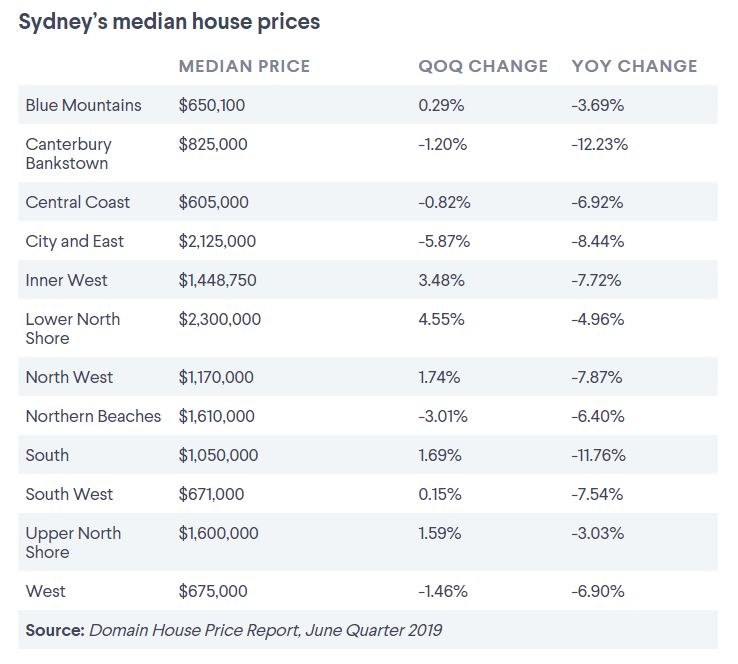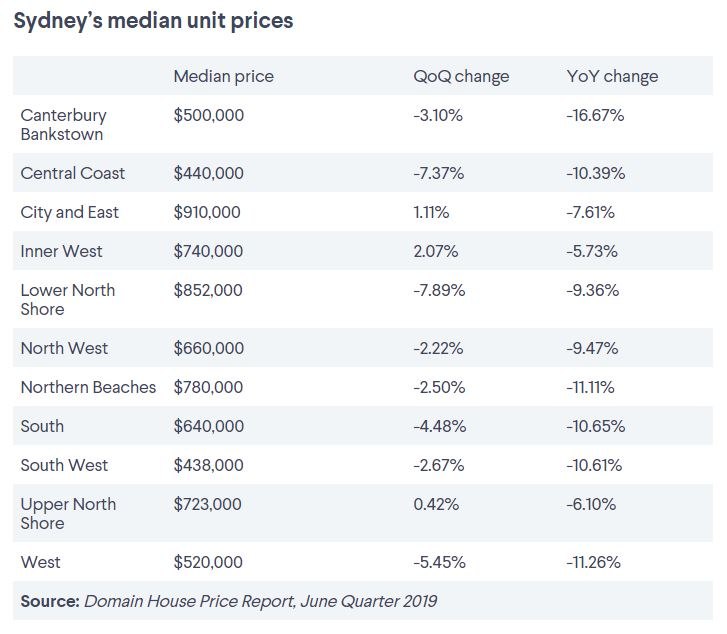Source: TAWAR RAZAGHI, JOURNALIST, DOMAIN - JUL 24, 2019
Sydney's largest correction in house prices since the 1980s appears to be near its end, with prices increasing in more than half of the city's regions in the June quarter, new data shows.
Overall, the city's house and unit price declines have slowed to 0.4 per cent – the smallest quarterly fall since prices started sliding in December 2017, according to Domain's June House Price Report, released on Thursday. And Sydney's median price is likely to stay above $1 million.
The citywide median house price has dropped to $1,032,338 – back to early 2016 levels while the median unit price has dropped to $688,652, back to mid-2015 levels.
“It's likely that prices have bottomed out in Sydney recently,” said Domain economist Trent Wiltshire. “This is the biggest downturn in property prices since the 1980s … it looks to be at least close to an end.”
Mr Wiltshire said while it was a short-lived correction, it was significant in nominal terms.
House prices fell 14 per cent below the mid-2017 peak but Sydney's median house price is likely to remain above $1 million, according to Mr Wiltshire.
He said the latest report captured a period of seismic shifts within the property market, including the federal election results, which guaranteed negative gearing and capital gains tax remained in place, two interest rate cuts and lending rule changes.

As a result, demand surged as buyers returned to the market yet supply did not catch up in turn, according to agents, pushing up prices.
EY chief economist Jo Masters said the market would not bounce back, despite the downturn abating.
“Whilst we've had APRA reduce the serviceability floor, there's the introduction of comprehensive credit reporting … we will still see some credit restraint,” she said.
Mr Wiltshire said the recovery was skewed to higher-priced areas: lower north shore house prices recorded the strongest growth of 4.55 per cent to $2.3 million in the June quarter. It was followed by the inner west, up 3.48 per cent to $1,448,750.
Ray White upper north shore selling agent Anna Cavill said open-home numbers on the weekend after the election, returning to 2017 numbers.
She said that when prices dropped, it brought in a wider pool of buyers previously locked out of the area.
“When the lower north shore and inner west has more to spend, there's always that knock-on effect,” Ms Cavill said.

Claudia Clamer is selling her Normanhurst home in a few weeks and feels hopeful given it is just one of a handful of homes for sale there.
“[It] shares the same postcode as Wahroonga but is more affordable than Wahroonga,” Ms Clamer said. “That bodes really well, it's been opened for just two weeks and more than 90 groups have gone through. It's had really good interest.”
The upper north shore median increased 1.59 per cent to $1.6 million in the quarter ending in June.
Over the quarter, Melbourne median house prices rose 0.3 per cent, which Ms Masters said was was due to the city's stronger population growth and lower supply compared to Sydney.
She said Sydney prices would stabilise in spring as more sellers came into the market while demand remained the same, finding a “new equilibrium”.
Raine & Horne Newtown director Duncan Gordon said there was a real shortage of supply.
“All these buyers are trying to buy at once but there's nothing to buy,” said Mr Gordon. “Sellers won't react as quickly as buyers, there will be a lag – sellers want more confidence.”
He said properties have sold between $200,000 and $500,000 above reserve in the past months as a result of pent up demand.
“In the height of the market in 2017, we wouldn't have thought we would get that. It absolutely defied all odds.
“Demand is strong and supply is low. That's what's caused this volatile activity in the marketplace. Until that [supply] level is up then these results will continue to happen.”

